美世-总体薪酬报告Total-Rewards-Sales-Presentation-cn-revised
- 格式:ppt
- 大小:5.55 MB
- 文档页数:8

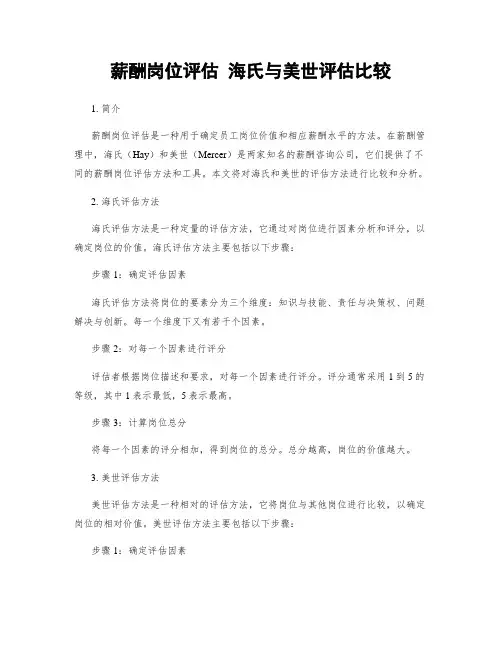
薪酬岗位评估海氏与美世评估比较1. 简介薪酬岗位评估是一种用于确定员工岗位价值和相应薪酬水平的方法。
在薪酬管理中,海氏(Hay)和美世(Mercer)是两家知名的薪酬咨询公司,它们提供了不同的薪酬岗位评估方法和工具。
本文将对海氏和美世的评估方法进行比较和分析。
2. 海氏评估方法海氏评估方法是一种定量的评估方法,它通过对岗位进行因素分析和评分,以确定岗位的价值。
海氏评估方法主要包括以下步骤:步骤1:确定评估因素海氏评估方法将岗位的要素分为三个维度:知识与技能、责任与决策权、问题解决与创新。
每一个维度下又有若干个因素。
步骤2:对每一个因素进行评分评估者根据岗位描述和要求,对每一个因素进行评分。
评分通常采用1到5的等级,其中1表示最低,5表示最高。
步骤3:计算岗位总分将每一个因素的评分相加,得到岗位的总分。
总分越高,岗位的价值越大。
3. 美世评估方法美世评估方法是一种相对的评估方法,它将岗位与其他岗位进行比较,以确定岗位的相对价值。
美世评估方法主要包括以下步骤:步骤1:确定评估因素美世评估方法将岗位的要素分为若干个因素,如技能要求、责任范围、工作条件等。
步骤2:对每一个因素进行评分评估者根据岗位描述和要求,对每一个因素进行评分。
评分通常采用1到5的等级,其中1表示最低,5表示最高。
步骤3:与其他岗位进行比较将岗位的评分与其他岗位进行比较,确定岗位的相对价值。
评估者可以使用美世提供的数据库和工具进行比较分析。
4. 比较与分析海氏和美世评估方法在评估岗位价值的方式上存在一些差异。
- 定量 vs. 相对评估:海氏评估方法是一种定量的评估方法,它根据岗位的因素评分来确定岗位的价值。
而美世评估方法是一种相对的评估方法,它将岗位与其他岗位进行比较来确定岗位的相对价值。
- 评估因素的不同:海氏评估方法将岗位的要素分为三个维度,每一个维度下有若干个因素。
而美世评估方法将岗位的要素分为若干个因素。
两种方法在评估因素的选择上存在差异。
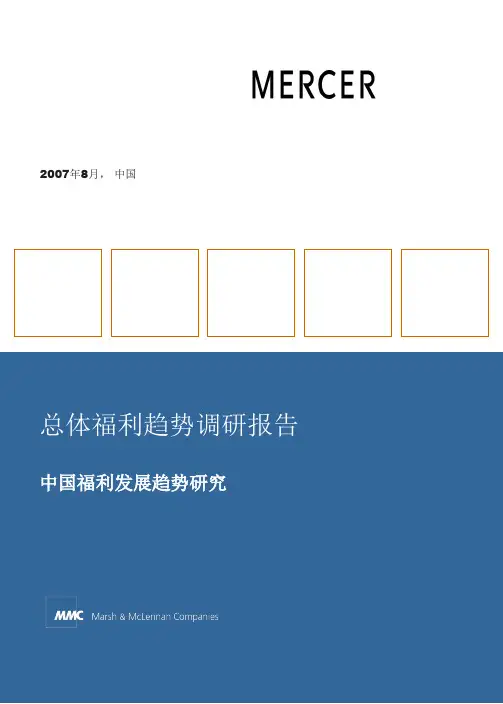
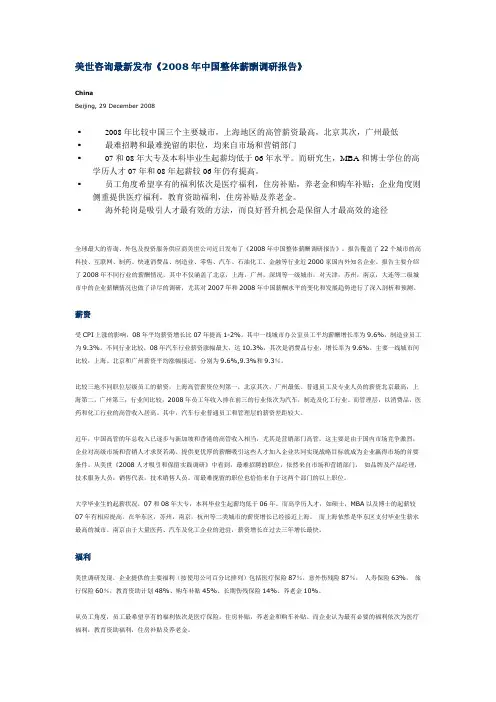
美世咨询最新发布《2008年中国整体薪酬调研报告》ChinaBeijing, 29 December 2008▪2008年比较中国三个主要城市,上海地区的高管薪资最高,北京其次,广州最低▪最难招聘和最难挽留的职位,均来自市场和营销部门▪07和08年大专及本科毕业生起薪均低于06年水平。
而研究生,MBA和博士学位的高学历人才07年和08年起薪较06年仍有提高。
▪员工角度希望享有的福利依次是医疗福利,住房补贴,养老金和购车补贴;企业角度则侧重提供医疗福利,教育资助福利,住房补贴及养老金。
▪海外轮岗是吸引人才最有效的方法,而良好晋升机会是保留人才最高效的途径全球最大的咨询、外包及投资服务供应商美世公司近日发布了《2008年中国整体薪酬调研报告》。
报告覆盖了22个城市的高科技、互联网、制药、快速消费品、制造业、零售、汽车、石油化工、金融等行业近2000家国内外知名企业。
报告主要介绍了2008年不同行业的薪酬情况,其中不仅涵盖了北京,上海,广州,深圳等一级城市,对天津,苏州,南京,大连等二级城市中的企业薪酬情况也做了详尽的调研,尤其对2007年和2008年中国薪酬水平的变化和发展趋势进行了深入剖析和预测。
薪资受CPI上涨的影响,08年平均薪资增长比07年提高1-2%。
其中一线城市办公室员工平均薪酬增长率为9.6%,制造业员工为9.3%。
不同行业比较,08年汽车行业薪资涨幅最大,达10.3%,其次是消费品行业,增长率为9.6%。
主要一线城市间比较,上海、北京和广州薪资平均涨幅接近,分别为9.6%,9.3%和9.3%。
比较三地不同职位层级员工的薪资,上海高管薪资位列第一,北京其次,广州最低。
普通员工及专业人员的薪资北京最高,上海第二,广州第三;行业间比较,2008年员工年收入排在前三的行业依次为汽车,制造及化工行业。
而管理层,以消费品,医药和化工行业的高管收入居高。
其中,汽车行业普通员工和管理层的薪资差距较大。
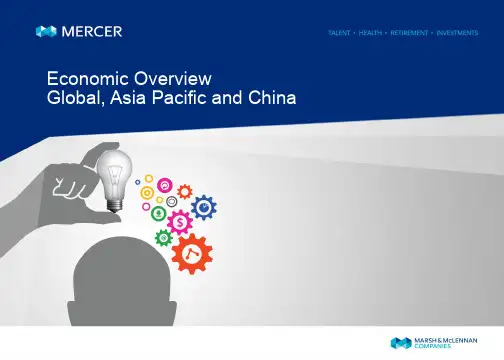
Economic Overview Global, Asia Pacific and ChinaMERCER1World GDP and InflationGDP goes up and Inflation goes down from 2013 to 2015Source: IMF World Economic Outlook (April, 2014) -2.00.02.04.06.08.010.020082009201020112012201320142015Emerging market anddeveloping economies Inflation 9.2 5.4 5.9 7.3 6.0 5.8 5.5 5.2 Emerging market anddeveloping economies GDP 5.9 3.1 7.5 6.3 5.1 4.7 4.9 5.3 World Inflation6.02.53.64.93.93.63.53.4World GDP2.7 -0.45.2 3.9 3.2 3.0 3.6 3.911/10/2014Shift in Global Business Landscape Driving corporate growth in Asia PacificSource: APAC Exec Brief, August, 2014, IMA AsiaAsia Pacific still leading the packTo cash in where the growth is today, and for the foreseeable future,Increasing focus on Asia Pacific4.3% GDPgrowth1.1% GDPgrowth2.0% GDPgrowthAsia Pacific vs. Developed markets11/10/2014MERCER 2MERCERRegional GDP, Inflation & Salary Increase0%2%4%6%8%10%12%3Source: IMA Asia Brief Aug 2014Mercer Global Compensation Planning Report 2014 July*Mercer TRS Surveys 2014 AU CN HK ID IN JP KR MY NZ PH SG TH TW VN GDP 3.0% 7.4% 2.5% 5.0% 4.9% 0.4% 3.6% 6.2% 3.3% 6.2% 3.2% 1.1% 3.8% 5.0% Inflation 2.6%2.5%3.8%5.7%7.3%2.7%1.5% 3.5%2.0% 4.6% 2.1% 2.3% 1.7%4.9%Salary Increase3.5% 7.5%*4.5% 10.0% 11.0% 2.1%5.0%5.6%3.0%7.0%4.5%5.9%3.8% 10.7%11/10/2014MERCER4-1-0.8-0.6-0.4-0.200.20.40.60.81North AmericaEurope and Central AsiaAsia and Pacific Latin America and the CaribbeanMiddle East and North Africa Sub-SaharanAfrica •Overall index is unweighted average of the four pillar scores•Scores are weighted by population; population data from United Nations Department of Economic and Social Affairs, World Population Prospects, rev. 2012.Source: The Human Capital Report, World Economic Forum, 2013The report is published in collaboration with MercerHuman Capital Index – by RegionHealth and WellnessEducationWorkforce and EmploymentEnabling EnvironmentHuman Capital Index11/10/2014MERCER Human Capital Index - China Rank #435CountryRank Score Switzerland 1 1.455 Finland 2 1.406 Singapore 3 1.232 Netherlands 4 1.161 Sweden51.111Japan 15 0.948 United States 16 0.920 Malaysia 22 0.644 China 43 0.186 Thailand44 0.158 Russian Federation 51 0.010 Indonesia 53 0.001 Brazil 57 -0.054 Mexico 58 -0.057 Vietnam 70 -0.202 India78-0.270Source: The Human Capital Report, World Economic Forum, 201311/10/2014MERCER6.0% 4.0% 2.0%0.0% 2.0% 4.0% 6.0%0-45-910-1415-1920-2425-2930-3435-3940-4445-4950-5455-5960-6465-6970-7475-7980-8485-8990-9495-99100+AsiaPopulation Demographics – Gender620102030Source: UN Population Statistics 2012MaleFemale11/10/2014MERCER7Population Demographics – Median AgeSource: UN World Population Prospects 2012510152025303540455055India ASEAN USA Australia China South Korea JapanMedian Age of the Total Population(Years)19902010203011/10/2014MERCERChina’s Changing DemographicsAge Group between 20 - 598Unit: thousandThe forecast of the future population adopts medium fertility rate assumption.Source: World Population Prospects: The 2012 Revision, United Nations50,000100,000150,000200,000250,00019901995200020052010201520202025203020-2930-3940-4950-5911/10/2014MERCERChina on Track for Moderate GrowthGDP, CPI, salary increase and turnover rate10.411.6139.6 9.110.49.37.87.77.4-2246810121416182005200620072008200920102011201220132014(E)2015(F)GDPCPI(Inflation Rate)Salary IncreaseStaff Voluntary Turnover2014 1st half year9Source : National Bureau of Statistics of ChinaIMA Asia (Aug 2014)2004-2014 Mercer Total Remuneration Survey6.712.213.514.611.315.716.313.6 13.613.47.28.68.28.76.98.59.69.48.2 7.97.57.7 1.84.81.55.9-0.73.35.42.62.82.52.611/10/2014China on Track for Moderate Growth GDP per capita1.Source: IMF World Economic Outlook (April, 2014).2.GDP is expressed in current U.S. dollars per person. Data are derived by first converting GDP in national currency to U.S. dollars and then dividing it by total population.3.For the ranking, there are 186 countries and regions with the data of GDP per. capita China’s Ranking of GDP per capitaYear Ranking 2011 91 2012882013 84 2014(F) 82 2015(F)81543460786747733379612011201220132014(F)2015(F)China GDP Growth Rate ForecastSource: China Forecast Book, IMA Asia ,2014 Q336912152010201120122013201420152016ManufacturingConstructionServicesGDPCHINA: GDP Growth by Component, %China’s Total Debt vs. GDPRaised rapidly since 2008 economic risk increasedSource: Financial Times reported on July 22, 2014, citing estimates from Standard Chartered.-20-1010203040G r o w t h P e r c e n t a g e (Y e a r -o n -y e a r )China FDI Growth Q1 Q2 Q3 Q4 Q1 Q2 Q3 Q4 Q1 Q2 Q3 Q4 Q1 Q2China Foreign Direct Investment (FDI)Source : Ministry of Commerce of the People’s Republic of ChinaSource: World Investment Report 20142011 2012 2013 2014100124 2013 FDI FlowFDI Outflow FDI InflowUSD, Billion201450.254.14546474849505152535455PMI Manufacturing PMI ServiceAug Sep Oct Nov Dec Jan Feb Mar Apr May Jun Jul AugChina PMI : Manufacturing and ServicesSource: HSBC September, 20142013 2014ServiceHighest since Mar 2013Down Again after 3-month upManufacturingGlobal Innovation Index rankingsInnovation – A Path to TransformationChina has improved its innovation from 2013 to 2014Country/EconomyScore(0-100)2014 Rank2013 RankSwitzerland 64.78 1 1 United Kingdom 62.37 2 3 Sweden62.2932United States of America 60.09 6 5 Hong Kong (China) 56.82 10 7 Japan52.412122China46.572935Russian Federation 39.14 49 62 Brazil 36.29 61 64 India33.707666Source: The Global Innovation Index 2014Cornell University, INSEAD, and the World Intellectual Property Organization (WIPO )Summary•China still has strong-to-moderate GDP growth rate in next 3 years.•Economic risk is raising due to stimulation.•China may become a FDI net outflow country in 2014.•China is on the way improving its Human Capital Index and innovation ranking in the world, while the aging population will be a issue, China has to seek way to offset its negative impact.New Technology BringsNew Practices of Talent ManagementSource: CBN Weekly 2014HR Revolution with business changeHiring CommunicationLearning&SavingDevelopmentFrom Graduates’ points of view•Strong financialpower •Competitivebenefits •Innovative culture •Inspiring leadership •Attractive companyproducts/services•Innovative culture•Fast promotion•Job Security•Performance-basedbonus•Fast promotion•Entrepreneurshipenvironment•Grey area•Compensation forovertimesBut lack of…Graduate Top 3 PreferencesMNCSOEPOEOWN-BIZSTART-UPFIFA World Cup and Social Network350,000 tweetsPer day1,000 + million discussion 62%out of500 millionOnce upon a time…“……以最饱满的诚意,招聘最优秀的人才加盟,共同谱写辉煌的未来!”我们将遵循公平、公正的原则择优录用,同时提供具有竞争力的薪酬待遇和广阔的发展空间,欢迎优秀人才积极报名应聘。

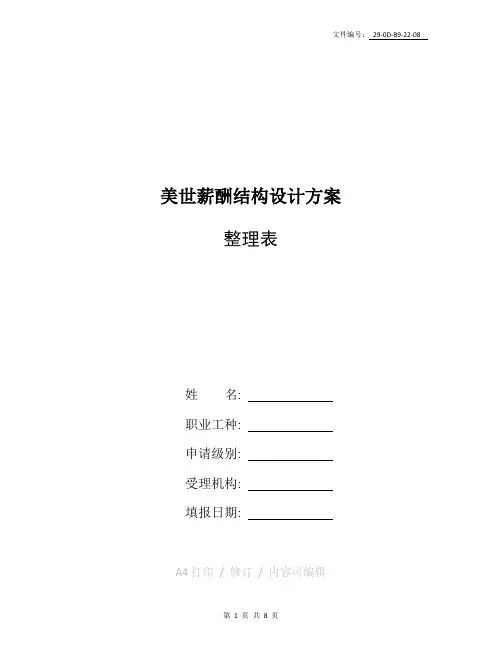
美世薪酬结构设计方案整理表姓名:职业工种:申请级别:受理机构:填报日期:A4打印/ 修订/ 内容可编辑公司薪酬调整建议方案一、总体思路与原则1、此次薪资调整为三个重点:其一,调整企业内部的薪资结构;其二,调整员工的薪资构成比例,体现以岗位和职务为基础,按照贡献和绩效支付劳动报酬的原则;其三,简化企业和员工薪资等级和结构,增大薪资机制的作用弹性。
2、本着保证员工原有的报酬水平,特别是低薪人员的收入水平不降低的原则,主要通过增量工资进行两个薪资结构的调整。
3、明确以岗位工资+ 津贴补贴+ 绩效工资为主的薪资制度4、岗位工资是主干工资制度,实施分类定级方式,即管理、专业、业务、事务和操作人员分别制定薪资级别,企业薪资结构为分类别的梯度等级结构。
5、调整后的员工薪资结构为:员工薪资 = 岗位薪资 + 技能津贴(学历、职称、工龄) + 补贴(法定补贴、企业福利)+ 奖励(月奖、业绩奖)6、视各公司效益情况,固定工资(岗位工资、技能津贴和补贴)与浮动工资(奖金、佣金、分红)比重应控制在60- 70% 和20-30%区间内。
二、岗位(职务)等级工资采用统一的五类定级法,即打乱公司行政隶属界限,将所有企业的正式员工的岗位统一划分为管理、专业、业务、事务和操作人员,分别定级,并纳入一张企业薪资表(见附表1、2)中,具体为:1.管理人员分为5个职务等级;2.专业人员分为4个岗位等级;3.业务人员分为3个岗位等级;4.事务人员分为2个岗位等级;5.操作人员分为2个岗位等级;各类岗位职务之间经对应交叉后,合并为10个薪资等级。
三、技能津贴有两个因素促使本次薪资调整必须降低技能因素在薪资中的作用:其一是突出岗位薪资和绩效薪资的比重;其二是原有薪资中,政策性补贴占的比重很大,不宜降得过低,故只能适当降低技能工资的比重。
为此,采取以下方式调整:1.将技能薪资分为两部分,50%左右纳入岗位薪资中;另50%作为技能津贴处理。
2.技能津贴中包括学历、职称和工龄三个因素,分别确定等级和工资级差。
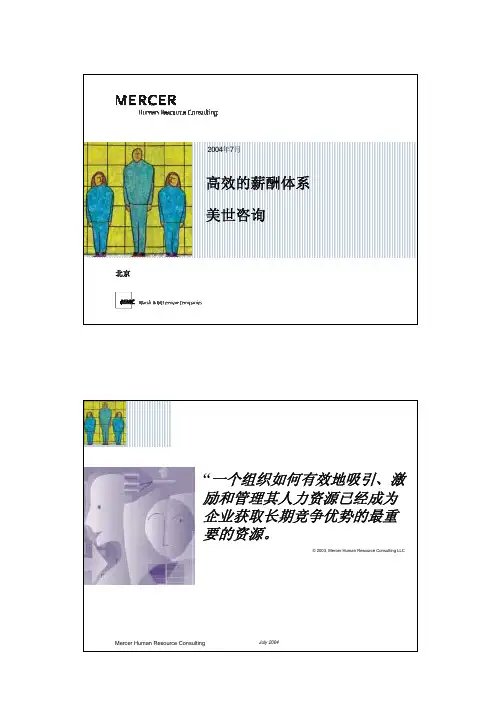
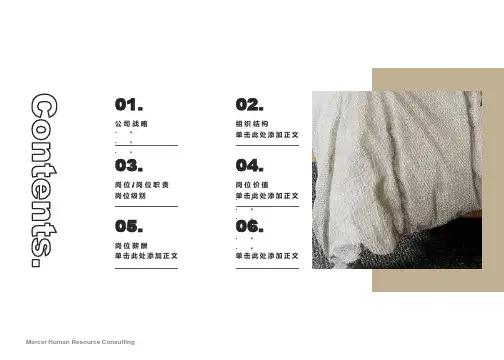
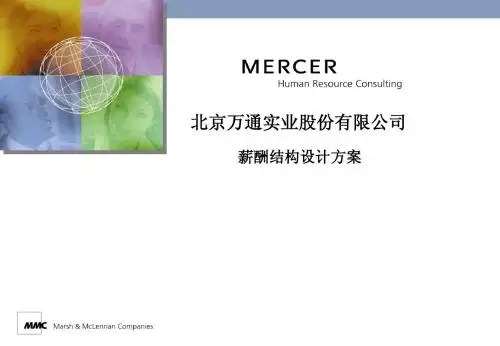

美世咨询-人力资源高效的薪酬体系讲义PDF2004年7月高效的薪酬体系美世咨询北京"一个组织如何有效地吸引,激励和管理其人力资源已经成为企业获取长期竞争优势的最重要的资源.2003, Mercer Human Resource Consulting LLCMercer Human Resource ConsultingJuly 2004从战略的角度看待人力资源管理Mercer Human Resource ConsultingJuly 2004从财务的角度看HR…人力资源方面的投入接近收入的36%...Source: 2002, CFO Research/Mercer study…但只有16%左右的CFO表示他们对于人力资源的效率有一定理解Mercer Human Resource ConsultingJuly 2004… 因此,公司都在考虑转换人力资源部门的角色…US §¨ b 进开 Canada 13% Latin America 11% Europe 9% Asia 7% Australia 9% 75% 7% 74% 12% 75% 9% 76% 9% 62% 14% 25% 50% 8%美世全球的调查表明, 越来越多的公司考虑转换人力资源部门的角色为什么?为了能够适应更激烈的市场竞争Source: Transforming HR for Business Success, Mercer Human Resource Consulting, 2003Mercer Human Resource ConsultingJuly 2004有些公司通过横向比较衡量人力资源管理是否有效……通过与类似公司比较宏观数据,衡量人力资源管理的有效性…确定人力资源决策的重要参考数据为评价人力资源管理有效性提供依据从宏观角度发现值得研究的问题找到与同类公司的差距Mercer Human Resource ConsultingJuly 2004Overview 简介CBM can help you on the following aspects:公司基准调研能在以下方面为您提供帮助: - Improved understanding of internal HRM systems and itseffectiveness加深对内部人力资源管理体系和有效性的理解- An external perspective leading to the establishment of morerelevant HRM goals提供外部视角以建立与业务更加密切相关的人力资源管理目标- Becoming aware of industry best practices 更加了解行业最佳实务- Becoming more competitive in the marketplace 在市场中更具竞争力Mercer Human Resource ConsultingJuly 2004Overview 简介33 key HR benchmarks across 7 categories:涵盖7个大类的33个关键人力资源基准– Staffing ratios 员工配置比率– Human resources budgets 人力资源预算– Salary costs and profit ratios 薪酬成本与利润比率– Training 培训– Employee turnover 员工流失– Sick leave 病假– Overtime and recruitment 加班与招聘Mercer Human Resource ConsultingJuly 200433 Benchmarks - I 33个基准(一)HR staff as a percentage of total staff Payroll staff as a percentage of total staff Training staff as a percentage of total staff Finance staff as a percentage of total staff IT staff as a percentage of total staff Marketing staff as a percentage of total staff Sales staff as a percentage of total staff Training expenditure per employee Percentage of employees provided with training Training expenditure as a percentage of base salary costs Annual training hours per employee Voluntary staff turnover Involuntary staff turnover Total staff turnover Sick leave days per employee Sick leave rateMercer Human Resource Consulting人力资源人员占全体员工的比例工资管理人员占全体员工的比例培训人员占全体员工的比例财务人员占全体员工的比例信息技术人员占全体员工的比例市场人员占全体员工的比例销售人员占全体员工的比例人均培训费用培训费用相当于基本工资的比例培训覆盖率(获得培训员工占全体员工的比例) 员工年平均培训小时数自愿离职率非自愿离职率整体离职率人均病假天数病假率July 200433 Benchmarks - II 33个基准(二)HR budget per employee HR budget as a percentage of sales turnover Payroll function budget per employee Payroll budget as a percentage of revenue Hours overtime - office staff Hoursovertime - factory staff Days to fill clerical vacancy Days to fill professional vacancy Days to fill middle management vacancy Days to fill senior management vacancy Recruitment cost –clerical/secretarial staff Recruitment cost –professional staff Recruitment cost –middle management Recruitment cost –senior management Base salary costs per employee Employee benefits as a percentage of base salary costs Profit per employee Mercer Human Resource Consulting人均人力资源部门预算人力资源预算占销售收入的比例人均工资管理预算工资管理预算占销售收入的比例付薪加班小时数–办公室职员付薪加班小时数–工厂/运营/制造员工文员/秘书的招聘周期(天) 专业人员的招聘周期(天) 中层管理人员的招聘周期(天) 高层管理人员的招聘周期(天) 文员/秘书的招聘成本专业人员的招聘成本中层管理人员的招聘成本高层管理人员的招聘成本人均基本工资员工福利占基本工资的比例人均利润July 2004举例4.00HR Staff as % of Total Staff3.00% HR Staff2.001.000.00 JP HK AUJuly 2004SGTHVTMercer Human Resource Consulting举例Employee benefits as % of base salary7060Employee Benefits (%)50403020100 JP HK AUJuly 2004SGTHVTMercer Human Resource ConsultingCase Study- linking business to HRM 案例分析- 战略与人力资源管理的联接1.272857Mercer Human Resource ConsultingJuly 2004如何提高人力资源管理的有效性?Mercer Human Resource ConsultingJuly 2004人力资源部门的现状人力资源部门的挑战是如何使自己从大量的日常行政管理中解脱出来,参与到公司的战略规划中去.人力资源部门的时间分配 21% 9% 24% 16% 25% 28% 12% 14% 11% 23%0% 5% 10% 15% 现状期望 20% 25% 30%最佳实践: 23.2%战略合作伙伴设计人力资源管理系统提供人力资源服务控制和审核日常行政管理和数据统计最佳实践: 14.9%Mercer Human Resource ConsultingJuly 2004人力资源发展规划的建立受制于企业的经营战略,企业内外的具体环境,并且与组织系统相协调以支持企业的股东价值目标组织结构有形资产不管是明确的,还是不明确的,每个企业都有一个人力资源战略经营战略资产人力股东利益经营环境由于整个系统的内部相关连性,所以几乎系统的任何一个部分发生重大变化都会影响到其他任何剧烈的市场变化或经营模式的改变都会需要企业人力资源发展规划作出相应的调整Mercer Human Resource ConsultingJuly 2004人力资源发展规划的形成需要系统考虑企业组织系统中相辅相成的六个方面,从而保证发展规划对经营结果的支持作用人员能力经验培训和教育人员搭配报酬货币/非货币形式工作本身长/短期激励职业晋升决策参与决策的义务决策制定的速度与质量参与权力分散流程工作流程部门的相互依靠角色和责任职位设计管理结构汇报关系和要求目标详述绩效管理信息与知识交流机制与流程信息交流信息资本的利用/创造信息系统July 2004Mercer Human Resource Consulting人力资源管理职能的建立和完善应基于公司整体人力资源发展战略的要求按优先顺序进行招聘: ·人才策略·人才规划·职位管理·招聘流程·人才选拔组织机构: ·组织设计·职位体系建立·职业生涯规划·继任者计划·领导力发展薪酬管理: ·职位评估·薪酬策略·市场调查与预算·薪酬结构培训和发展: ·素质模型·培训需求分析·培训计划·培训组织和实施·培训效果评估绩效管理: ·绩效指标体系·绩效管理流程·目标分解和沟通·绩效结果应用·福利计划·激励制度·高管薪酬·工资发放员工关系: ·员工沟通·团队建设·法律纠纷·员工态度调查·员工档案整体的设计将有提高人力资源管理的系统性,有利于各职能的整合合理的规划将大大提高人力资源运做的效率Mercer Human Resource Consulting劳动安全: ·安全教育·安全档案·设备/工种管理·工伤处理人力资源信息系统: ·信息系统策略·信息系统结构·功能整合·员工自我服务人力资源部门建设: ·人力资源战略·人力资源机构设计·计划与预算·人力资源服务模型/ 分级管理July 20043P模型Mercer Human Resource ConsultingJuly 2004美世的3P模型职位职位澄清职位澄清职位评估职位评估薪酬薪酬绩效目标设定目标设定绩效评估绩效评估员工发展员工发展个人Mercer Human Resource ConsultingJuly 2004组织结构设计的概念模型产生规模效益产生规模效益结构/部门划分结构/部门划分促进信息交流促进信息交流设计的目标设计的目标契合设计的模式设计的模式协调方式协调方式改善员工行为改善员工行为管理流程管理流程Mercer Human Resource ConsultingJuly 2004系统的分析方法保证组织的各层次协调配合,保证战略目标实现了解业务明确:使命,价值观念和战略发现组织所承担的职责组织确认职责设计组织架构和分配职责研讨职位分析绩效目标职位职位评估绩效评估薪酬能力/个人发展July 2004部门/结构可以有多种划分方式产品客户地域技能/职能流程大多数情况下是以上划分方式的组合Mercer Human Resource ConsultingJuly 2004组织架构的方式总町地域诟国国际职能慵场运营慵场运营产品A B C DA B C DA B C DA B C D例2总町销售 (职姻)慵场 (职姻) 财务产 (职姻) 煅蒸资旯 (职姻) July 2004沔产 (产 )国际(ò )(职姻)围绕地域设计的组织结构(例)总经理职能专家产品经理北方区经理中部区域经理南方区域经理分公司经理Mercer Human Resource Consulting July 2004职能划分的组织结构(例)总经理研发部采购部生产部财务部设计部计划部销售部在大型生产企业中比较常见Mercer Human Resource Consulting July 2004围绕流程设计的组织结构(例)总经理计划采购Sheet Metal ShopCut metal to sizePress ShopShapes MetalFabrication ShopJoins metal sections by weldingFinishing ShopPaints/ enamelsAssembly ShopAssembles finished productsDespatchDelivers products to customerMost whiteware manufacturers use this split in their manufacturing divisionsMercer Human Resource ConsultingJuly 2004举例总裁总裁助理法律审计部总裁办公室执行总裁投资集团监察部公共关系副总裁-行政副总裁-财务物流集团总经理研发中心物流中心行政办公室供应中心生产制造中心MIS部财务俄罗斯/东亚区人力大中国区乌克兰区非洲/中东区东南亚区东欧区西欧区东亚区北美区南美区物流市场Mercer Human Resource ConsultingJuly 2004信息沟通要求- 组织结构的首要目的是促进组织内信息的有效沟通,企业往往在不了解信息沟通需求的情况下确定了组织结构生产生产产工艺人力资源人力资源计划和预测生技术技术技术要求销售销售信息系统信息系统预算和成本财务财务财收入和利润信息务数据市场市场日常支持业务战略客户服务客户服务战略策划战略策划Mercer Human Resource ConsultingJuly 2004营销集团组织结构间协作方式等级/汇报关系结构性协作方式管理流程非正式组织Mercer Human Resource ConsultingJuly 2004项目实施方案:概述步骤 1. 公司现状分析步骤 2. 新组织结构设下职责澄清步骤 3. 沟通和实施步骤 4. 职位设计理解目前的业务战略部门职责分析获得公司职责列表根据业务流程发现信息流动要求结合发展战略确定总部与地区关系确定框架明确部门职责和分工部门内职位设计管理层讨论明确部门职责制定职位说明书项目启动及项目组动员管理层访谈明确现状和问题收集信息理解当前管理方式确定方案和实施沟通和确认与高管层工作会议Mercer Human Resource ConsultingJuly 2004职位分析Mercer Human Resource ConsultingJuly 2004职责匹配,一个分析组织有效性的有力工具什么是职责匹配? –职责匹配是将部门的职责分解到各岗位的一种分析工具职责匹配的目的: –分析,澄清各项工作执行过程中各相关岗位之间的职责关系,分配工作,分清职责边界,以加强合作,减少误解或扯皮现象Mercer Human Resource ConsultingJuly 2004职责匹配的工具——ARPCIA-V审批(Approval-Veto):审核以批准或否决的权利R 主要负责(responsibility): 负责启动并跟踪某一活动,并确保该活动的顺利完成,对该活动的结果负责.主要是"管理"该活动 ,不一定需要亲自完成它 P参与(Participate):做为行动小组成员之一参与该活动C咨询(Consultation):为某活动提供咨询,建议I告知或获悉(Inform):必须被告知,但是没有直接影响力Mercer Human Resource ConsultingJuly 2004职责匹配的应用保留当前状况的ARCPI稿,从当前状况出发根据工作的需求进行职责调整调整的重点是R和P 参照组织架构图,尽量使A-V和R在一条汇报线上调整的过程中沟通十分重要,需要由团队的经理或管理小组讨论决定根据ARCPI的分析结果,归纳整理,并描述各具体岗位的职责注意各岗位的汇报线关系,明确相应的组织架构Mercer Human Resource ConsultingJuly 2004如何撰写精确又适用的岗位说明书Mercer Human Resource ConsultingJuly 2004The Roles 角色沟通Communication 公司的要求Expected role 承诺Commitment 激励 Motivation 完成的任务 Fulfilled role 个人的理解 Perceived role 岗位说明 Position clarification 业绩合同 Performance contract双方同意 Accepted role工作表现Performance 薪酬Compensation 固定Fixed 浮动Variable组织结构 Organization有效 Effectiveness 成功 Success更新 Adaptation战略政策 Strategy竞争 CompetitionMercer Human Resource ConsultingJuly 2004The Position is the Smallest Unit of an Organization 岗位是组织的最小单元 Function/Roles岗位Function 职能Organization 组织Structure结构Division / Unit 分支机构/单位Areas of Responsibility 职责范围Department / Unit 部门/小组Position 职位 Position 职位 Position 职位… As such, its existe nce, nature and definition depend on the company's business strategy 就如以上所说,岗位的存在,性质和定义都是由公司的战略所决定的Mercer Human Resource Consulting。
美世薪酬体系设计专题二人薪酬结构设计目录01薪酬理念和战略分析02现状诊断03方案设计•薪酬结构要素(薪酬等级、中位值、级差、幅宽等)•套入分析和结构验证薪酬现状诊断薪酬结构确定•薪酬内部公平性•薪酬外部竞争性•企业运营战略和整体薪酬战略•内外部分析薪酬理念和战略分析123薪酬结构设计流程1.目标公司期望通过薪酬策略达成何种目标?2.原则指导薪酬策略的原则是什么?3.公平性①公司如何定义 “公平性”?②“公平性”在达成薪酬策略目标的重要性如何?4.竞争性公司如何定义“竞争性”?“竞争性”在达成薪酬策略目标的重要性如何?1.付薪能力2.竞争性的职级设置!企业前提企业性质企业文化企业价值观企业历史- - - - - - - -- - -付薪原理1内部分析实际运作期望业务趋势价值增值- - - - - - - -- - -事实和比率2外部分析新概念旧概念竞争对手其他- - - - - - - -- - -事实和比率3薪酬理念和策略目标指导原则公平性竞争性- - - - - - - -- - -薪酬组合与影响4资本市场客户市场劳动力市场薪酬对比组的建立必须与公司未来股东/投资者的期望相符(如上市地点、行业、规模大小、业绩水平的高低等因素)必须充分考虑企业的人才竞争市场,我们是与哪些企业(行业、地区)竞争关键人才?我们是与哪些企业(行业、地区)在业务上存在竞争?薪酬理念和战略分析 对比组的选取选择合适的薪酬市场或对比组是进行薪酬设计最重要的一环①一般对比组的选择通常会综合考虑以下要素:所处的行业、公司的规模、劳动力竞争市场、企业发展阶段、企业的性质、上市地等②对比组的选择需考虑数据的可采性以及公司处于以下的三个市场:25分位50分位(中位值)75分位与市场相符内部因素•高赢利•公司进入一新环境或一新市场•人员规模扩大•人员流失率高•需要吸引高质量人才•工作前景不明朗•缺乏职业发展机会外部因素•在业内对具备某些技能、经验的人才需求大•人才竞争激烈•比对公司其一般的薪酬定位岗位价值固定薪酬水平•赢利水平低•稳定的增长•人员规模缩减•人员流失率低•满足于目前高效的团队•工作前景明朗稳定•职业发展机会多•在业内对具备某些技能、经验的人才供应充裕•人才竞争并不激烈•比对公司其一般的薪酬定位薪酬理念和战略分析 整体薪酬战略选取•考虑内、外部因素,选择适合企业情况的薪酬定位:创业型成长型成熟型衰退型重建型经营上的考虑重点n 市场份额n运营资金n销售额的增长率n投资n盈利n保持市场上的位置n股东价值创造n成本控制n毛利/回款n优化、整合资源n减低成本n回款n重新定位n重建资源n减低成本n回款n投资人力资源的需要n吸引和保留员工n吸引人才和保留关键员工n 吸引和保留关键员工n保留关键人才n吸引新进人才薪酬策略n相对比较低的固定工资n适中的短期激励n较大比例的长期激励n具有竞争力的固定工资n较大的短期激励比例n适度至较大比例的长期激励n提供非常有竞争力的固定工资n适度至比例大的短期激励n较小比例的长期激励n具有竞争力的固定工资n适度至比例大的短期激励n小量的长期激励n具有竞争力的固定工资n适中的短期激励n适度至较大比例的长期激励薪酬理念和战略分析 薪酬组合选取企业根据自身发展所处的不同阶段有不同的薪酬策略目录01薪酬理念和战略分析02现状诊断03方案设计薪酬现状分析•内部公平性是对组织内部薪酬公平性的评估,就各个岗位的薪酬水平与其相对内在价值的相关度进行分析内部公平性分析外部竞争性分析•外部竞争性是对企业薪酬实践的外部竞争力的整体评估。
薪酬岗位评估海氏与美世评估比较一、引言薪酬岗位评估是组织中对不同岗位进行薪酬水平评估的一种方法。
通过对不同岗位的工作内容、责任、技能要求等进行评估,可以确保薪酬体系的公平性和合理性。
在薪酬岗位评估领域,海氏(Hay Group)和美世(Mercer)是两家知名的薪酬咨询公司,它们提供了不同的评估方法和工具。
本文将对海氏和美世的薪酬岗位评估进行比较,以便帮助组织选择适合自身需求的评估方法。
二、海氏薪酬岗位评估海氏薪酬岗位评估方法是一种定量的评估方法,它将岗位分解为多个因素,并为每个因素分配权重,通过对每个因素的评分和加权求和,得出岗位的总分。
海氏薪酬岗位评估的特点如下:1. 因素分解:海氏将岗位分解为不同的因素,例如工作内容、责任、技能要求等。
这样做可以更加准确地评估岗位的价值。
2. 权重分配:海氏为每个因素分配权重,以反映其在岗位中的重要性。
不同的因素对于不同的岗位可能有不同的权重分配。
3. 评分和加权求和:对于每个因素,海氏根据其在岗位中的表现进行评分,然后将各因素的评分加权求和,得出岗位的总分。
4. 薪酬水平决策:根据岗位的总分,海氏可以确定岗位的薪酬水平,从而为组织提供决策依据。
三、美世薪酬岗位评估美世薪酬岗位评估方法是一种定性的评估方法,它将岗位分为不同的层级,并为每个层级定义了一组特定的要求和职责。
美世薪酬岗位评估的特点如下:1. 层级划分:美世将岗位划分为不同的层级,每个层级对应一组特定的要求和职责。
这样做可以更加方便地对岗位进行比较和分类。
2. 职责定义:对于每个层级,美世定义了一组特定的职责和要求,以帮助组织更好地理解和评估岗位。
3. 定性评估:美世通过对岗位的职责和要求进行定性评估,将岗位与不同层级的标准进行比较,以确定岗位所属的层级。
4. 薪酬水平决策:根据岗位所属的层级,美世可以确定岗位的薪酬水平,从而为组织提供决策依据。
四、海氏与美世评估比较海氏和美世都是薪酬岗位评估领域的知名公司,它们提供的评估方法有一些共同点,也有一些差异。
mercer薪酬调研报告Title: Mercer Salary Survey ReportIntroduction:The Mercer Salary Survey Report aims to provide an in-depth analysis of compensation trends and practices across industries and regions. This report presents a comprehensive overview of salary data, including insights on pay levels, salary increases, benefits, and other relevant factors affecting employee compensation. In this report, we examine the findings from the Mercer Salary Survey, offering valuable insights for organizations and professionals alike. Overview:The Mercer Salary Survey collects data from various organizations to create a comprehensive salary database. This database is then utilized to conduct detailed analyses of salary trends, allowing for a robust comparison and benchmarking process. The survey covers a wide range of industries, including finance, technology, healthcare, manufacturing, and more, providing a holistic view of compensation practices.Key Findings:1. Salary Levels: The report highlights the variation in salary levels across industries and geographies. It reveals that finance and technology sectors generally offer higher compensation compared to other industries. The report also delves into city-specific analysis, illustrating the impact of regional factors on salary levels.2. Salary Increases: The report examines the average salary increase offered by organizations worldwide. It presents insightsinto the factors impacting salary raises, such as industry growth, performance, and talent scarcity. The findings help organizations understand the competitive landscape and make informed decisions regarding salary adjustments.3. Benefits and Incentives: The report explores the benefits and incentives offered by organizations alongside base salary. It sheds light on popular benefits such as health insurance, retirement plans, flexible work arrangements, and bonuses. Additionally, it discusses emerging trends in employee benefits, including wellness programs and professional development opportunities.4. Gender Pay Gap: A crucial aspect of the report is its analysis of the gender pay gap. It provides a detailed examination of the disparities between male and female employees' compensation levels, highlighting the persistent challenges organizations face and the necessary steps to achieve pay equity.Conclusion:The Mercer Salary Survey Report serves as an invaluable resource for organizations, HR professionals, and employees in understanding the current compensation landscape. By studying salary levels, trends, and benefits across industries and geographies, organizations can make more informed decisions regarding compensation packages. Furthermore, professionals can use this report to benchmark their own salaries, negotiate effectively, and gain insights into career progression opportunities.In conclusion, the Mercer Salary Survey Report serves as a reliable and comprehensive guide for both organizations and professionals,offering insights that help drive informed decision-making in the realm of compensation. With its extensive analysis and findings, this report provides a deeper understanding of the complex dynamics that shape salary structures and practices in today's workforce.。